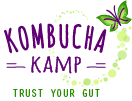
Do you want a good carbonation from your kombucha? I’m the Kombucha Mamma and I’m here to share my 7 tips for fizzy kombucha!
Kombucha is naturally fizzy. Effervescence is a natural byproduct of kombucha fermentation in which yeast creates invertase and uses it to snip glucose and fruit sugar molecules into monosaccharides. CO2 (fizz) and ethanol (alcohol) are the results of that process. In a way, ethanol acts as a preservative by protecting our craft beer against pathogens. Also, ethanol can become a food source for the bacteria. So, they consume the ethanol and convert it into healthy acids, leaving only a tiny amount of alcohol. Finally, ethanol is medicinal in small doses. Therefore, you are able to reap all of the benefits of the booch more easily.
So here are my best tips for achieving a good fizz
- Add Heat During Primary Fermentation. Several studies suggest that Kombucha has a specific temperature range – around 25° Celsius or 77° Fahrenheit. That’s when we see the best production of acetic acid (the dominant acid in kombucha). For this reason, we say the ideal temperature range for your kombucha is 75-85°F.
- You must have a tight cap for your bottles or container. Reusing commercial Kombucha bottles is a great idea to start, but over time the caps can wear out. Using Replacement Caps or sourcing better bottles for ferments such as flip-tops will improve carbonation as well since these will seal in the Carbon Dioxide more effectively.
- Leaving just a centimeter or so of space at the top off the bottle forces more Carbon Dioxide to remain dissolved in the liquid, making it less likely to escape through the bottle seal.
- Sugar is what sparks yeast, and the yeast are responsible for the bubbles. 1/2 teaspoon of straight cane sugar (THRIVE, AMZ) per 16oz bottle should crank up the Kombucha carbonation. Ginger can also have a strong effect. Even flowers such as chamomile have natural yeast that can boost the bubbles. Fruit and juice do the same, especially pureed fruit which really fires up the fizz. Be careful and burp your bottles daily to prevent explosions!
- leave the bottles at room temperature to continue building carbonation, especially if you are checking the bottles and no bubbles are happening yet. 1-2 hours at room temperature is often enough to “re-awaken” the brew after refrigeration. The cold liquid stores more CO2, so as it warms up, the bubbles are released and ready to rumba.
- Add a heater to the second ferment to boost fermentation and CO2. Cold conditions reduce the activity of the yeast. Also, colder liquid can hold more CO<2, but when warmed the bubbles are pushed to leave the liquid. As always, check to make sure you don’t overcarbonate the brews by burping your bottles regularly.
I hope this video encourages you to try carbonating your Kombucha if you haven’t before. Once you fall in love (and I know you will) – then come learn to make your own Kombucha with a free recipe and illustrated DIY Guide on KombuchaKamp
Timestamp
- 0:41 Check out the difference between “forced” bubbles and natural bubbles
- 1:09 Ethanol? Will Kombucha get me drunk?
- 2:49 How to keep your Kombucha warm and cozy in the winter
- 3:51 How to Bottle your ‘Buch
- 4:40 Hold up, I want to know how to flavor my Kombucha NOW
- 7:43 What if my Kombucha OVERcarbonates?
- 9:20 Kombucha cuddles
- 10:25 Kits, Cultures, and Supplies – Oh My!
Additional Resources:
- How to Choose a Cloth Cover for Kombucha and JUN with Kombucha Kamp
- Kombucha and Alcohol: How to Control Alcohol in Kombucha
- Kombucha Kocktails: The Advantages of Combining Kombucha with Alcohol
- Does Kombucha really need sugar to make kombucha? – Kombucha Recipe FAQ – 2021
- Kombucha Benefits: How Much Kombucha to Drink? with Hannah Crum of Kombucha Kamp

Mel
May 16, 2023 at 8:32 pmGrapes, cut in half during the second fermentation. And smaller 2nd fermentation vessels.